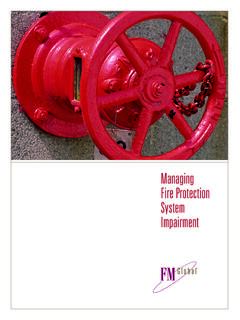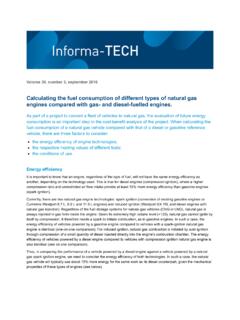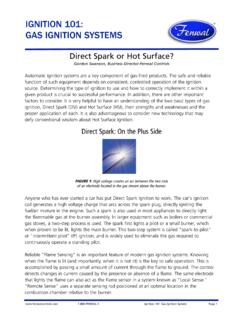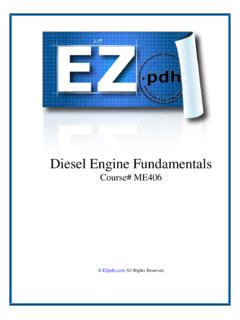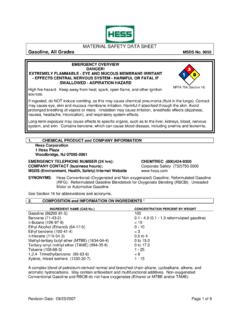Transcription of Ignition Sources: Recognizing the Causes of Fire
1 Ignition Sources: Recognizing the Causes of FireIgnition Sources: Recognizing the Causes of Fire 2 of 10 This brochure is made available for informational purposes only in support of the insurance relationship between FM Global and its clients. This information does not change or supplement policy terms or conditions. The liability of FM Global is limited to that contained in its insurance policies. In today s highly competitive busi-ness environment of just-in-time production and tightly woven inter-dependencies, a fire at your facility could mean more than just damage to your property. It could affect your ability to resume normal business operations, causing an extended pe-riod of downtime. When a company can t provide product, its customers go elsewhere, its brand evaporates, competitors move in and shareholder value FM Global, we believe the foundation of any sound property protection program is understand-ing.
2 To protect your facility from the hazards that threaten it, you first must understand those hazards and how they will affect continued business operations. To protect your facility from fire and explosion, you need to be able to recognize potential igni-tion sources and which could prove Ignition source need only con-nect with combustible material in the presence of oxygen to quickly ignite a fire or explosion. With knowledge of what it takes to cause a fire at your facility, you can better prevent or control fire. You can take action to isolate Ignition sources inherent to an operation, or prevent the introduction of others. And, you can educate and train employees to watch for specific hazards, perform safely and respond correctly to minimize danger if a fire does Sources: Recognizing the Causes of Fire 3 of 10 Although Ignition sources are as nu-merous and varied as the facilities in which they hide, they can be grouped into three categories.
3 Essentially, the three types of Ignition sources include those that are: inherent in processes or equipment caused by equipment failure, improper design or lack of needed protection systems introduced by human interven-tion or other occupanciesWhile your FM Global engineer can provide tailored recommendations to meet your specific business needs, this brochure will help you under-stand the different types of Ignition sources that threaten productivity and the safeguards you can take to help ensure against a fire or explosion at your Sources Inherent in Processes or EquipmentWhen you think about the types of processes and machinery that are used in any given manufacturing facility, it s not surprising that this category of Ignition sources poses such a significant processes and types of equipment use open flames.
4 Pro-duce hot surfaces or create arcs/sparks all sources of Ignition included among the 10 most costly listed below. While these Ignition sources are inherent to the process or equipment and generally cannot be eliminated, there are steps you can take to safeguard your property from the likelihood of them causing a fire or explosion. The most important step is isolating the Ignition source from combustible or flammable the 10 most costly Ignition sources, those that are considered to be inherent in processes or equip-ment include: Electricity, or more specifically, the small arc that is created every time you turn on and off an elec-trical switch. If flammable gas is present, the switch becomes an Ignition source. Top 10 Ignition Sources (Ranked by Dollar Value) FM Global Insured Fires and Explosions, occurring 2007 2011 Cause Number Gross Loss (USD) (Indexed to 2012) Electricity 994 $ billion Hot Work 181 $713 million Spontaneous Ignition /Chemical Action 145 $543 million Hot Surfaces/Radiant Heating 272 $367 million Arson/Incendiarism 403 $342 million Overheating 246 $331 million Miscellaneous Spark 92 $325 million Open Flames (Excluding Hot Work) 100 $297 million Friction 68 $227 million Exposure 268 $100 millionIgnition Sources.
5 Recognizing the Causes of Fire 4 of 10 Static electricity/static charges are generated by several different mecha-nisms, including friction from mak-ing and/or breaking contact between solid surfaces. Common processes that can create electrostatic charges through friction include: A conveyer belt running over rollers Paper running through a printing press over a coating roll A powder material flowing into a bin or silo An operator removing plas-tic shrink-wrap from a pallet load of bagged raw material. Hot surfaces/radiant heating, which can be produced by elec-trical heating equipment, such as immersion heaters and extruders, pipes, boilers, furnaces, ovens, dryers, flues and ducts. Examples of possible scenarios include: A hot firebox igniting un-burned fuel oil Hydraulic oil leaking from a hose onto a hot surface A hot incandescent bulb igniting combustible mate-rial that is stored too close A hot grinding wheel igniting dust in a wood- working occupancy Open flames, such as pilot lights, which typically are found in industrial heating equipment and cooking appliances boilers, furnaces, space heaters, ovens, burners.
6 (Hot work is consid-ered an open flame, but treated as a separate Ignition source.) Examples of possible scenarios include: A heating appliance igniting a spilled ignitable liquid or released dust cloud Burner flames in boilers, dryers, ovens and furnaces igniting explosive concen-trations of fuel vapor or unburned fuel Burner flames igniting fuel, hydraulic fluid or other ignitable liquid leaking from a pipe Molten substances, which, typically, are either glass or metal that have been heated in a furnace to such a degree, the substance has melted and turned to allowed to come into contact with combustible or flammable material, these Ignition sources can cause a fire, and, possibly, costly physical damage and extended downtime, especially if the damage is to equipment that is hard to replace or critical.
7 In the case of molten substances, the potential for explosion also is Sources: Recognizing the Causes of Fire 5 of 10 Ignition Sources Resulting from Equipment Failure, Improper Design or Lack of Needed Protection SystemsEquipment that is electrically fed or has moving parts can produce unintended Ignition sources if not properly maintained, designed or provided with needed protection systems. Loose or improperly main-tained electrical connections, for example, can overheat or produce arcs. Undersized electrical power cables can overheat, and moving parts that are not adequately lubri-cated can produce frictional heating or safeguard your property from this group of Ignition sources, it s essential to follow good maintenance practices and ensure proper design of equipment. Of the 10 most costly Ignition sources, those that typi-cally result from equipment failure, improper design or lack of needed protection systems, are: Electricity, or more specifically, faulty wiring and electrical equipment.
8 While arcing, short circuits, electrical overloads and electrical sparks all factor into the electricity-related loss reported in the table on page 2, wiring and faulty electrical equipment often prove to be the source of Ignition . Severe damage could prove costly, especially if it brings production to a halt. Wiring. Improper installation or poor operating conditions can result in loose connections and arcing. Undersized electrical cables can overheat. Or, poor maintenance can allow heat, moisture, oil, corrosion, vibra-tion, abrasion or impact to dam-age wire or cable insulation. Electrical equipment. Electrical equipment needed for the distribution and utilization of power in facilities can malfunc-tion or overheat as a result of corrosion, loose connections or overload. If needed protection systems, such as ground fault interrupters (GFI) and circuit breakers, are not in place or of the proper size, you re left with-out safeguards to protect against such deficiencies.
9 Friction, which results when you fail to properly lubricate rotating and/or sliding equipment. Proper lubrication not only minimizes friction, but also provides cool-ing in the contact area. While it s natural to consume some lubri-cant in the process of normal operation, leaks or poor mainte-nance can aggravate the situ-ation. If the lost supply is not replaced, the motion between the surfaces can generate enough heat or sparking to ignite residue, dust or other combustible mate-rial in the area, including remain-ing lubricating oil. Overheating, which occurs when liquid, such as cooking oil and asphalt or material being processed in ovens, are heated beyond their points of Sources: Recognizing the Causes of Fire 6 of 10As with Ignition sources that are inherent in processes and equipment, electricity, friction and overheating can spark a fire capable of produc-ing extensive damage.
10 Depending on the severity, this damage could prove costly, especially if it brings produc-tion to a halt. Damage to equipment that is critical to your production process can result in extended busi-ness interruption, especially if a spare is not available or the equipment is unique in design and hard to the case of friction, the potential for explosion also is likely if dust is in the area. Between 2007 and 2011, FM Global clients have experienced 139 fires or explosion losses in-volving dust, totaling an estimated US$ million* in damage to their facilities. The average gross loss for a dust fire is US$ million*; the average gross loss for a dust explo-sion is US$ million*. Ignition Sources Introduced by Human Intervention or Other OccupanciesIn addition to Ignition sources that ei-ther are inherent in or created by pro-cesses and equipment, there are those that can be introduced through the actions or inactions of employees and contractors, or even fire spread from outside the facility.



